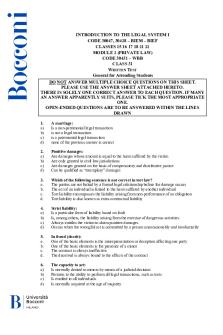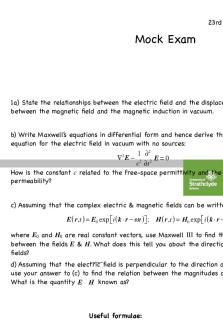Mock exam PDF

| Title | Mock exam |
|---|---|
| Course | Capital Markets and Asset Pricing |
| Institution | Johann Wolfgang Goethe-Universität Frankfurt am Main |
| Pages | 3 |
| File Size | 70.3 KB |
| File Type | |
| Total Downloads | 18 |
| Total Views | 160 |
Summary
winter...
Description
Mock Exam ’Capital Markets and Asset Pricing’ Prof. Dr. Holger Kraft Winter Term 2016/2017
February 1st, 2017 • Please check immediately if your exam problem set is complete. It should contain this cover page and 2 pages with questions. • Time: 90 minutes. • Tools: non-programmable calculator. • Please label your answers clearly. • The maximum number of points in every problem is 30, so that the maximum number of total points in the exam is 90. • The way you solve the problems must be evident. • Please write your student ID on each of the sheets you ultimately turn in.
1. Term structure of interest rates (30 Points) The term structure of spot rates is given by r (1) = 5%, r (2) = 5.75% and r (3) = 6.25%. The following treasury bonds are traded in the market. T K N
Bond 1 Bond 2 Bond 3 1 2 3 50 75 75 1000 1000 1000
(a) Calculate the bond prices and the continuously compounded forward rates. (b) Assume there is a fourth treasury bond that pays the following time dependent coupons Kt . t Kt
1 2 3 50 75 90
The current bond price is P = 1022 and the yield is 6.2%. Calculate the bond notional N . If you are not able to calculate the notional assume N = 1010 from now on. (c) Calculate the duration and convexity of the bond from part (b). (d) Approximate the price change of the fourth bond when the yield decreases by 200bp using (i) only the duration and (ii) duration and convexity. (e) More exact price sensitivity approximations can be obtained by taking additional derivatives of the pricing formula into account. Provide a formula for the term 3 F =−
d Price(y) dy 3
Price (y )
in case of a coupon bond and calculate F for zero coupon bonds with N = 100 and maturities of 1, 2 and 3 years. 2. State Pricing and CAPM (30 Points) In a one-period model there are three traded assets A1 , A2 and A3 with current prices P1 = 95, P2 = 60 and P3 = 55. In T = 1 three possible scenarios ω1 , ω2 and ω3 can occur. The values of the three assets in each scenario are summarized in the following table.
ω1 ω2 ω3
A1 2α 100 60
A2 95 α 30
A3 110 50 30
(a) For which values of α is the market complete?
1
(b) From now on assume α = 60. Calculate the prices of the elementary securities as well as the risk free rate. (c) A put option on A1 pays 0 in states ω1 and ω2 and 30 in ω3 . Calculate the strike price and determine the fair option value. (d) Assume the CAPM holds. The market return is µm = 0.08. The put option from (c) has a beta of −2. What is the physical probability that state ω3 occurs? (e) Calculate the risk neutral probability for state ω3 and explain the difference to your result from (d). If you are not able to calculate the physical probability, make a reasonable assumption. 3. CCAPM (30 points) We consider a one-period model for an economy that after one year is either in a boom or recession. If there is a boom, then GDP growth is 2%. Otherwise, GDP growth is -1%. Both states are equally likely. We assume that the representative agent has time-additive CRRA utility with a risk aversion of γ = 5. The time preference rate is δ = 1. (a) Calculate the risk-free rate in this economy. Now, we wish to price a financial asset paying 110 euros in a boom and 90 euros in a recession. (b) What is the expected payment of the asset at time 1? (c) What is the price of the asset at time 0? (d) Calculate the risk premium. Interpret your result.
2...
Similar Free PDFs

Mock exam
- 3 Pages

Mock Exam - exam
- 8 Pages

Mock Exam - exam
- 4 Pages

SBL MOCK EXAM 1
- 16 Pages

Mock Final Exam - Questions
- 11 Pages

MECO1001 Mock exam 2019
- 6 Pages

Mock exam 2019-2020
- 8 Pages

Revision & Mock Exam
- 22 Pages

Mock Exam C250 - Mock test questions
- 34 Pages

2020 nutrition mock exam
- 5 Pages

FFA Mock Exam 3 - FFA Mock Exam 3
- 46 Pages

Mock final exam
- 9 Pages

mock Exam 2017, answers
- 11 Pages

Electromagnetism Mock Exam 1
- 1 Pages
Popular Institutions
- Tinajero National High School - Annex
- Politeknik Caltex Riau
- Yokohama City University
- SGT University
- University of Al-Qadisiyah
- Divine Word College of Vigan
- Techniek College Rotterdam
- Universidade de Santiago
- Universiti Teknologi MARA Cawangan Johor Kampus Pasir Gudang
- Poltekkes Kemenkes Yogyakarta
- Baguio City National High School
- Colegio san marcos
- preparatoria uno
- Centro de Bachillerato Tecnológico Industrial y de Servicios No. 107
- Dalian Maritime University
- Quang Trung Secondary School
- Colegio Tecnológico en Informática
- Corporación Regional de Educación Superior
- Grupo CEDVA
- Dar Al Uloom University
- Centro de Estudios Preuniversitarios de la Universidad Nacional de Ingeniería
- 上智大学
- Aakash International School, Nuna Majara
- San Felipe Neri Catholic School
- Kang Chiao International School - New Taipei City
- Misamis Occidental National High School
- Institución Educativa Escuela Normal Juan Ladrilleros
- Kolehiyo ng Pantukan
- Batanes State College
- Instituto Continental
- Sekolah Menengah Kejuruan Kesehatan Kaltara (Tarakan)
- Colegio de La Inmaculada Concepcion - Cebu

